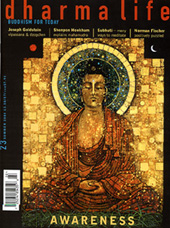Change in focus
Tibetan Buddhism teaches that the world we experience is an illusion created by the mind. So what happens when a lama makes a movie? Vishvapani reports on Travellers and Magicians a new film about Bhutan by Dzongsar Khyentse Rimpoche, director of The Cup.
The plane to Bhutan's Paro airport winds its way through the Himalayan foothills and then drops precipitously to a strip of runway set amid the craggy hills. The buildings - even the airport's control tower - are constructed in traditional Himalayan style, and the Bhutanese wear the traditional gho (national dress) by government decree. Visitors could be forgiven for imagining themselves in the position of the characters in The Lost Horizon who emerge from a plane crash into the forgotten kingdom of Shangri-La.
Bhutan is a special place. Tibet has changed utterly since the Chinese invaded in 1959. The other Himalayan kingdoms, Ladakh and Sikkim, have been absorbed by India and confronted by the full blast of modern culture. But Bhutan keeps its independence and, blessed with natural resources and a savvy, western-educated King, it has held the outside world at bay. The villages are largely untouched by the 21st century, and in Bhutan's 2,000 mountain monasteries a life continues of prayer, ritual and meditation that has hardly altered in centuries.
But beneath the tranquil surface, change is coming fast. Young people in the capital Thimphu, who grow up with cable TV and an English-language education, often feel distanced from Bhutan's traditions and the country's Vajrayana Buddhism. Most know little about its teachings, and can be as perplexed as westerners by its rituals and complex iconography. For the first time, there are reports of problems with drugs, crime and even violence.
Dzongsar Khyentse Rimpoche sounds like the embodiment of the very Buddhism that some young Bhutanese feel to be so distant from their lives. The 43-year-old is the tulku ('reincarnation') of Jamyang Khyentse, renowned as one of the greatest Tibetan Buddhist teachers of the last century. Dzongsar Khyentse spends several months of each year in strict meditation retreat and is the Abbot of several monasteries. But he has an unusual hobby for a lama - he also directs movies.
Having learnt his filmmaker's art as assistant to Bertolucci on the film Little Buddha, Khyentse went on to direct the Tibetan-language movie, The Cup, which charmed audiences worldwide with its down-to-earth portrait of Tibetan monks obsessed by the 1998 soccer World Cup. His new film, Travellers and Magicians, is the first movie in Dzongkha (Bhutan's official language) to be made for an international audience, and it engages directly with the issues facing young Bhutanese on the cusp of modernity.
Travellers and Magicians weaves together two stories. Dondup, a young government officer stationed in a rural outpost dreams of leaving Bhutan for the western world. When the chance comes to leave he finds himself stranded on the road with two other travellers - a monk and the beautiful Sonam. The monk recounts a tale that makes the film's second story: a moral fable from old Bhutan of pride, infatuation and loss. Caught between the attractions of love and escape, and with the counterpoint of the monk's wisdom, Dondup wavers. Should he leave or should he stay?
Dondup's dilemma mirrors the difficulties faced by Bhutanese society. Will the next generation turn its back on the country's traditions? Or alternatively, will the country retreat into a medieval time-warp? Can Bhutan find a way to engage with the world without losing touch with the sources of its distinctive magic?
Travellers and Magicians is being shown at film festivals around the world, and its warm reception means that it is likely to make it to the international art-house circuit. But like The Cup it avoids the temptation to sell westerners an idealised version of Himalayan life. No professional actors were used and the cast includes the chief regulator of the country's banking and financial institutions, a colonel in the King's Bodyguard, a monk trained in pure mathematics, a senior researcher with the government strategic planning think tank, employees of the local TV broadcasting corporation, a school principal, school children and farmers.
Although Khyentse's film-making career has surprised - even shocked - some traditionalists, it is an expression of his Buddhist commitment. He comments, 'People automatically associate film with money, sex and violence. But film is a medium. Some might raise their eyebrows at what I do, but they have forgotten that their revered traditions were once very modern and progressive.'
Khyentse's wish is to connect directly with people like Dondup who are caught between traditional Bhutan and the promise of the modern world. In Travellers and Magicians he communicates the experience of the Bhutanese to outsiders, but the film also holds a mirror up to the Bhutanese people themselves. And Khyentse suggests that such communication, ironically, is more possible for him as a filmmaker than as a lama.
In the traditional teaching role, he says, 'I have often felt I am sitting on a big throne and my so-called students are looking up at me in awe; they dare not ask questions, nor express their problems or feelings. I would like to sit next to the Bhutanese young people and let them talk about anything - drugs, sex, money - whatever they want to discuss.'
Jamyang Khyentse Rimpoche, Dzongsar Khyentse's forbear, was a famous practitioner of Tibet's traditional sacred dances. Dzongsar Khyentse has, it seems, found a new medium for a Buddhist teacher: the guru as film director.
Travellers and Magicians, produced in Bhutan by Prayer Flag Pictures, is distributed by Hanway Films, UK.



